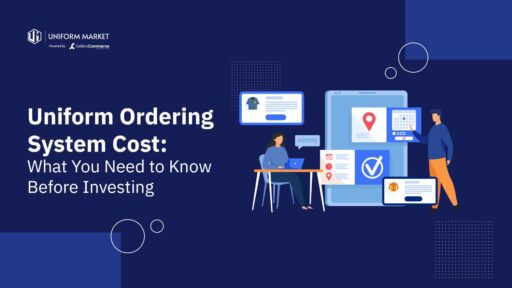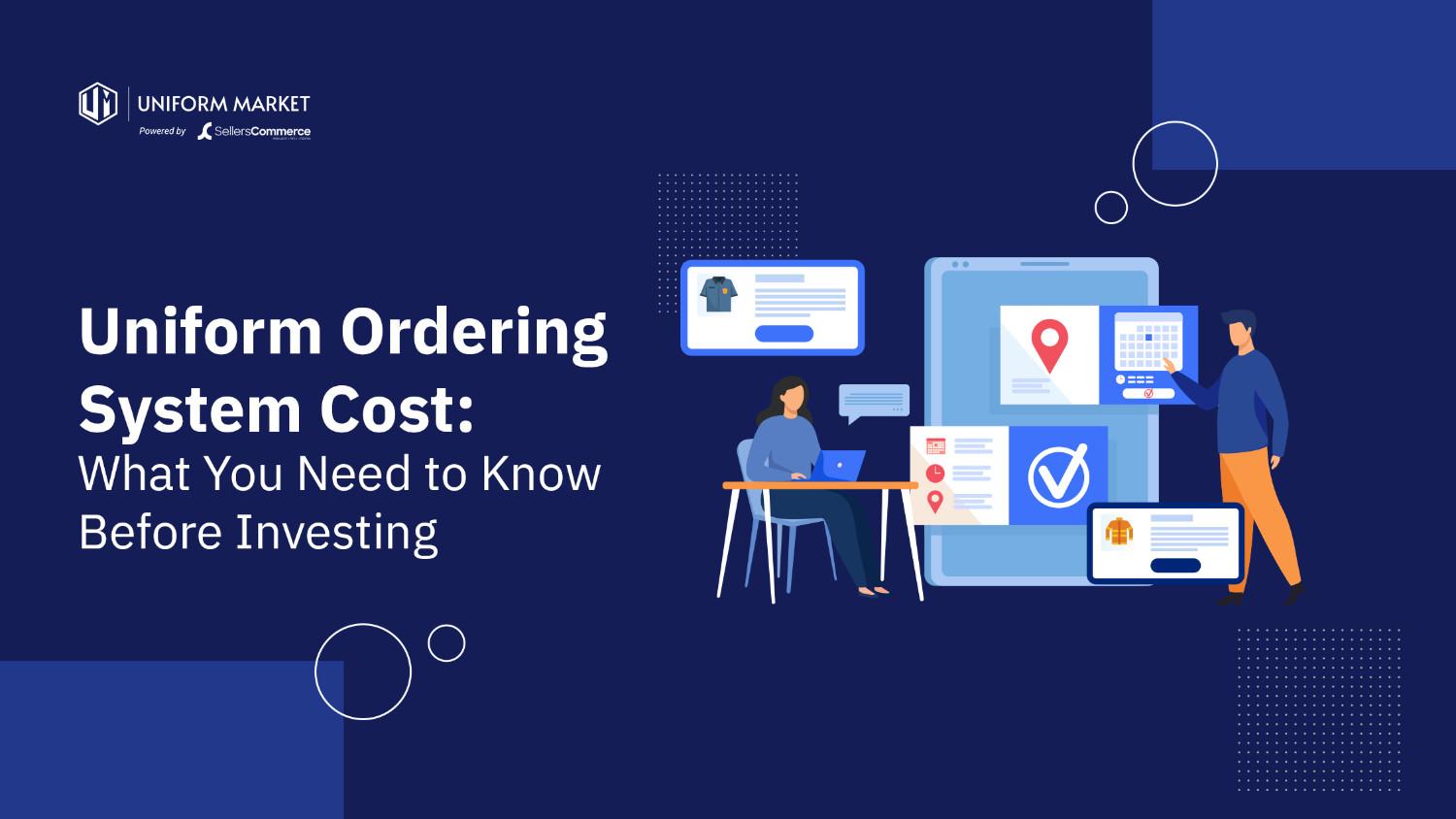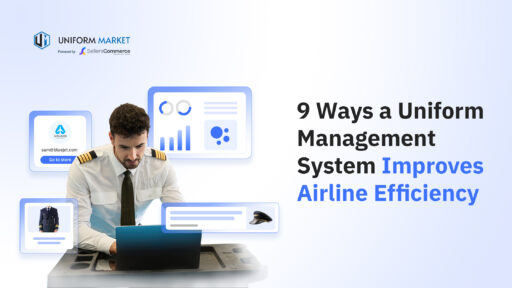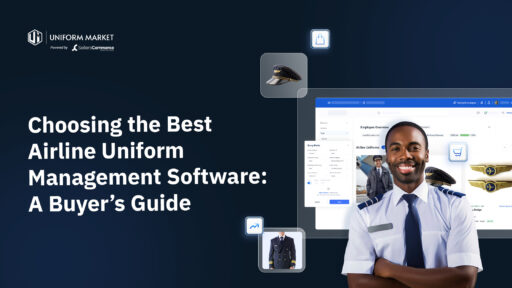Investing in a uniform ordering system is a significant step, especially for uniform suppliers managing large, complex apparel programs.
But to make a truly informed decision, you need to look beyond the initial price tag. The true cost of a uniform ordering system isn’t just about a monthly subscription; it’s a comprehensive calculation of value, efficiency, long-term savings, and client satisfaction.
Understanding this total cost of ownership is the key to unlocking sustainable growth and a powerful return on investment.
Why Uniform Ordering System Cost Deserves a Closer Look
First, let’s clarify what a uniform ordering system is. It’s not just another e-commerce platform. It’s a specialized, B2B software solution designed for manufacturers and distributors running sophisticated, client-branded uniform programs.
Understanding the Role of Uniform Ordering Systems in Modern Uniform Programs
These systems are the backbone of entitlement-based programs, where employees are allotted specific budgets or item allowances.
They automate complex rules, manage approvals, and provide a seamless, branded experience for your enterprise clients—transforming a logistical headache into a competitive advantage.
Evaluating Cost Beyond the Subscription Fee
When leaders see a price, they often stop there. But the subscription fee is just the tip of the iceberg. To accurately evaluate the cost, you must consider the entire ecosystem:
- Implementation and setup fees
- Support and training costs
- Integration with your existing technology stack
- The opportunity cost of not having an efficient system
Focusing only on the upfront price can lead to choosing a solution that costs you more in the long run through hidden fees, operational bottlenecks, and lost clients.
Breaking Down the Total Cost of a Uniform Ordering System
Software Licensing and Subscription Models
Most modern uniform ordering platforms operate on a Software-as-a-Service (SaaS) model. This means you pay a recurring fee for access to the software. Common pricing structures include:
- Per Portal/Store: A flat fee for each client-branded portal you operate.
- Per User: A fee based on the number of active users (employees) ordering uniforms.
- Tiered Pricing: Bundles that include a set number of portals, users, or features for a fixed price.
- Transaction-Based Fees: A model where the platform takes a percentage of the value of each order processed through the system. This can be attractive for businesses with fluctuating sales volume but can become costly as order values increase.
These models are designed to scale, allowing you to pay for what you need and expand as your business grows.
Implementation, Setup, and Training Fees
Getting a powerful system up and running requires an initial investment. These one-time costs typically cover:
- Onboarding: A dedicated team to guide you through the setup process.
- Configuration: Setting up client-specific rules, such as entitlements, budgets, shipping logic, and approval workflows.
- Training: Ensuring your team and your client’s administrators know how to use the platform effectively.
While it’s an upfront cost, a thorough implementation process is critical for long-term success and a smooth rollout.
Integration with Existing Systems (ERP, Inventory, Payroll)
A uniform portal doesn’t live in a vacuum. Its true power is unlocked when it connects seamlessly with your other business systems. The costs here can vary. Many platforms offer pre-built integrations with popular ERP, inventory management, payroll and punchout systems. However, if you have a custom or legacy system, you may need to budget for API development or custom integration work. This investment is crucial for automating data flow and creating a single source of truth.
Ongoing Maintenance, Support, and Upgrades
The partnership with your software provider doesn’t end after launch. Ongoing costs ensure your system remains secure, efficient, and up-to-date. This typically includes:
- Technical Support: Access to help when you need it.
- Bug Fixes & Maintenance: Ensuring the platform runs smoothly.
- Feature Updates & Upgrades: Gaining access to new tools and improvements without having to pay for a new version of the software.
How the Right System Reduces Operational Costs
A strategic investment in a uniform ordering system actively drives down your operational expenses.

Automating Manual Processes for Efficiency
Think about the hours your team spends manually processing orders via email, phone, or spreadsheets. A dedicated system automates these tasks:
- Order Entry: Employees place their own orders through a self-service portal.
- Approvals: Orders are automatically routed to the correct managers for approval based on pre-set rules.
- Entitlement Management: The system automatically tracks budgets and allowances, preventing manual lookup and errors.
This automation frees up your administrative team to focus on high-value activities like client relationships and growth.
Minimizing Order Errors and Customer Support Overhead
Manual processes are prone to human error—wrong sizes, incorrect products, or shipping to the wrong location. These mistakes are expensive, leading to returns, re-ships, and frustrated clients. A rules-based system minimizes these errors by ensuring employees can only order what they are authorized to receive. This drastically reduces returns and the customer support time spent fixing mistakes.
Empowering Self-Service for Enterprise Clients
Modern portals empower your clients’ administrators with role-based access. They can manage their own employee rosters, view reports, and oversee budgets without needing to contact your team for every minor request. This self-service capability not only streamlines their workflow but also reduces your internal customer service burden.
Cost Comparison: Generic vs. Purpose-Built Platforms
The choice between a generic e-commerce store and a specialized uniform management platform has significant cost implications. While a generic platform might seem cheaper upfront, the long-term operational costs often tell a different story.
| Feature / Cost Factor | Generic E-commerce Platform | Purpose-Built Uniform Platform (e.g., UniformMarket) |
| Upfront Cost | Lower initial subscription fees. | Higher initial investment, but includes configuration and onboarding. |
| Entitlement Management | Not available. Requires manual workarounds or expensive custom development. | Built-in. Automatically enforces budgets, allowances, and rules, reducing admin cost. |
| Approval Workflows | Basic or non-existent. Manual intervention is required for order approvals. | Built-in. Fully automated, multi-level workflows reduce management time. |
| Order Error Rate | High. Lack of rules leads to incorrect orders, increasing return and re-ship costs. | Low. Rules-based ordering minimizes mistakes, directly cutting operational costs. |
| Admin & Labor Cost | High. Requires significant manual effort to manage programs and support users. | Low. Automation and self-service features dramatically reduce administrative overhead. |
| Scalability for B2B | Limited. Difficult to manage multiple complex client programs efficiently. | High. Designed to scale and manage hundreds of unique client portals from one backend. |
| Total Cost of Ownership | High. Hidden costs from labor, errors, and custom development add up quickly. | Lower. Higher upfront cost is offset by massive long-term operational savings and efficiency. |
The Hidden Costs of Manual and Generic Solutions
Sticking with outdated methods or trying to adapt a generic B2C e-commerce store comes with significant hidden costs.
Time Wasted on Manual Order Management
Spreadsheets, emails, and phone calls are incredibly inefficient for managing complex uniform programs. Every order requires manual verification of entitlements, products, sizes, and shipping details. This administrative drag slows down fulfillment and creates a constant backlog, preventing your team from focusing on proactive client management.
Increased Return Rates and Inventory Errors
When ordering isn’t guided by a rules-based system, mistakes are inevitable. Employees might order the wrong items, exceed their allowance, or duplicate orders. This leads directly to:
- Higher Return Rates: Costing you shipping and restocking fees.
- Inventory Discrepancies: Making it harder to forecast demand.
- Increased Fulfillment Costs: Wasted labor and materials on incorrect orders.
Missed Opportunities Due to Limited Capabilities
In today’s market, large enterprise clients expect—and often demand—a sophisticated, branded ordering portal. If you can’t offer one, you may be disqualified from major contracts before you even get a chance to bid. The inability to support complex entitlement rules or provide detailed reporting is a competitive disadvantage that can stunt your growth.
Scalable Pricing Models to Fit Any Business Size
You don’t need to be a massive corporation to afford a top-tier system. The best providers offer flexible pricing that aligns with your business reality.
Pay-as-You-Grow and Tiered Pricing Structures
These models are perfect for growing businesses. You can start with a basic plan that covers your current needs and seamlessly upgrade to higher tiers as you win more contracts and add more clients. This eliminates the risk of overinvesting in features you don’t need yet.
Per-Store or Per-User Cost Models Explained
This approach allows for granular cost control.
- Per-Store: Ideal if you manage a few large programs. You pay a predictable fee for each client portal.
- Per-User: Works well for programs with a large, fluctuating number of employees. You only pay for the active users in the system.
Aligning Cost with Stage of Business Growth
The key is to find a vendor whose pricing model can evolve with you. As you scale from 10 client programs to 100, your ordering system should support that growth without requiring a massive, prohibitive cost increase.
Built-In Features That Drive ROI
The right features don’t just add to the cost; they are investments that deliver a tangible return.

Entitlement and Budget Controls to Prevent Revenue Leakage
This is one of the most critical ROI drivers. By enforcing strict rules on what and how much an employee can order, the system prevents over-ordering and ensures clients stay within their budgets. This stops revenue leakage and demonstrates your value as a disciplined program manager.
Role-Based Access and Approval Workflows
Giving client-side administrators the power to manage their own teams is a game-changer. They can assign permissions, approve orders, and pull reports themselves. This reduces your administrative workload and gives your clients the control they crave.
Multi-Program and Multi-Client Support
The ability to manage dozens or even hundreds of unique, branded client programs from a single administrative backend is the definition of efficiency. It allows you to scale your operations without linearly increasing your headcount.
Customization Costs: What’s Standard vs. Optional
Understanding what’s included versus what costs extra is key to accurate budgeting.
Branded Portals and Reporting Dashboards
Most top-tier systems include white-label branding as a standard feature. Your clients will see their logo and colors, not the software provider’s. Standard reporting dashboards are also typical. Custom analytics or highly specialized reports, however, may come at an additional cost.
Custom Rules, Integrations, and Workflow Enhancements
Here’s where the line between configuration and customization becomes important.
- Configuration: Adjusting settings that are already built into the platform (e.g., setting up a new budget rule). This is usually included.
- Custom Development: Building a brand-new feature or a complex, bespoke integration. This will almost always be a separate, quoted project.
Hidden Fees to Watch for in Vendor Agreements
Always read the fine print. Be wary of vendors who have:
- Strict Support Limits: Charging extra for support calls or tickets.
- Aggressive Feature Gating: Making essential features (like certain reports or integrations) part of a much more expensive tier.
- Costly Upgrade Paths: Forcing you into a massive price jump for a small increase in usage.
The Cost of Not Offering a Modern Portal Solution
Sometimes the most significant cost is the one you incur by doing nothing.
Losing Large Contracts to More Tech-Savvy Competitors
For large RFPs, a modern ordering portal is no longer a “nice-to-have”; it’s a prerequisite. If your competitors offer a seamless, automated, and professional online experience and you’re still relying on spreadsheets, you will lose out on major growth opportunities.
Impact on Customer Experience and Brand Perception
A clunky, confusing, or non-existent ordering process reflects poorly on your company. It creates friction for your clients and their employees, damaging your brand reputation. A sleek, modern portal, on the other hand, enhances your image as a professional, tech-forward partner.
Challenges in Scaling Without a Robust Ordering System
You cannot scale a complex uniform program on manual processes. As you add more clients, the administrative burden will become overwhelming. Without a centralized, automated system, your service levels will drop, errors will increase, and your growth will hit a wall.
Calculating the ROI of a Uniform Ordering System
To justify the investment, you need to calculate the return.
Labor Cost Reductions and Time Savings
Estimate the number of hours your team spends each week on manual order entry, answering basic questions, and fixing errors. Multiply that by their hourly wage. A good system can reduce this administrative time by 70-80%, representing a direct labor cost saving.
Faster Fulfillment and Fewer Mistakes
How much do returns and re-ships cost you annually? By reducing order errors, a system directly impacts your bottom line. Furthermore, faster, more accurate fulfillment leads to happier clients.
Higher Retention and Recurring Revenue
What is the lifetime value of an enterprise client? By providing a superior, streamlined experience, you dramatically increase client satisfaction and loyalty. This makes them less likely to switch suppliers, securing your recurring revenue for years to come. The portal becomes a key part of the value you provide, making your service stickier and more defensible.
Making a Smart Investment in Uniform Program Technology
Recap: Balancing Cost with Value
The true cost of a uniform ordering system is not the monthly fee. It’s the balance between the total investment and the immense value it delivers through operational efficiency, error reduction, enhanced client satisfaction, and scalable growth. Viewing the system as a cost center is a mistake; it’s a strategic investment in the future of your business.
Next Steps: How to Choose the Right Vendor for Your Needs
When evaluating providers, look beyond the price and consider these factors:
- Industry Specialization: Do they understand the complexities of uniform programs?
- Scalability: Can their platform grow with you?
- Support & Partnership: Do they offer robust support and act as a partner in your success?
- Integration Capabilities: Can they connect with your existing tech stack?
- Client References: Can they provide case studies or references from businesses like yours?

